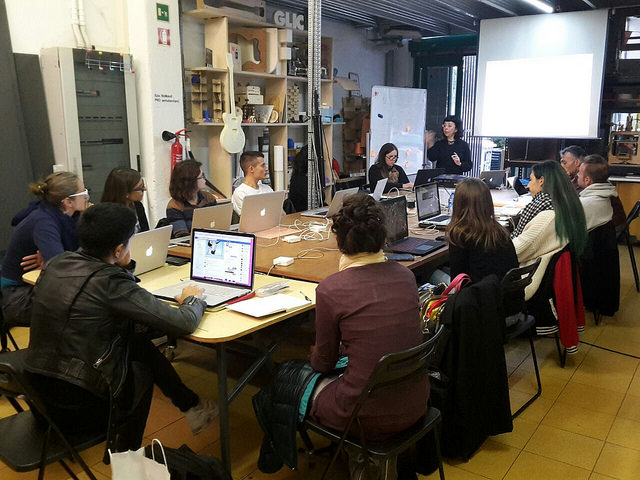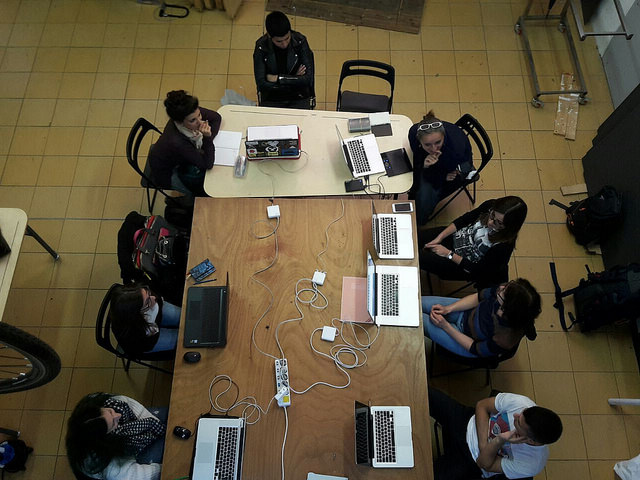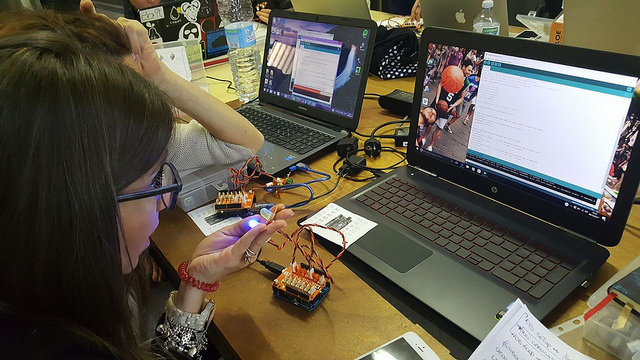WoW Woman in STEM | Zoe Romano, craftivist, digital strategist and lecturer
Interview by Marija Butkovic @MarijaButkovic
Zoe Romano is a craftivist, digital strategist and lecturer focused on social impact, women in tech, digital fabrication, open design. She graduated in Philosophy, worked for several years in digital communication agencies and, at the same time, developed her social skills as media hacktivist on precarity, material and immaterial labor in the creative industries. She worked for Arduino as digital strategist from 2013 to 2017 and then co-founded WeMake Makerspace in 2014 where she now works full-time. WeMake is a hub of the following networks: Fabricademy, WearSustain, TCBL. She’s been working on three EU funded projects: openwear.eu, opencare.cc and digitalsocial.eu.
What is the idea behind your Makerspace and how did you come up with it?
In the ’00 I used to be part of various collectives which were experimenting with technology and reflecting on how the experience of “work” was changing compared to our parents. We used to organise presentations, also courses and exhibitions in local squats in Milan. We covered different topics from new forms of organising around exploitation in the creative industries, gentrification of urban areas, new productions’ approaches inspired by free software movement and hacking as an attitude toward reality, very similar to the makers motto: “if you can’t open it you don’t own it”. In those years I was active in this field in my free time and my “real job” was in another sector. I felt that what we were doing in squats could have a lot of impact in changing the idea that citizens are just mere consumers, but also to empower a series of local producers in designing their own job.
When did all start and do you have other members in your team?
At the beginning I started to collaborate with Vectorealism, a laser cut service which is active here in Milan and connected with Ponoko, one of the first online laser cutting service for makers. I got in touch with Eleonora, the founder of Vectorealism, and proposed her to organised a workshop with her laser-cut and a series of open source pattern of fashion accessories I developed within a EU funded project I was coordinating, Openwear. Later we decided to buy a 3d printer together and start using it. We got a Makerbot Thing’o’matic kit and called a friend to help us assemble it. It was during those months of tinkering that we were discussing in informal groups how we could set up a lab. We were inspired on what was happening in United States, how the idea of hacking became an opportunity of emancipation through the idea of “making” able to involve a wider public. The hacker scene of the 90s and 00s was mainly composed by white western men, the Maker Movement was much more diversified since the beginning.
We also realised that managing a digital fabrication online service means limiting human interactions as much as possible in order to optimised the transactions and keep prices low. Opening a makerspace or fablab means focusing on the community and put people at the center. So among the initial group, Costantino Bongiorno and me decided to move forward and open a Makerspace.
How long did it take you to be where you are now?
It took us around 2 years. First we travelled around Europe and a bit of US to see how other makerspaces were managed. Secondly we started an itinerant event in Milan called PopupMakers. The format was simple, three makers showing 3 prototypes in 20 minutes each during aperitivo time once a month. It allowed us to start building a local community and see the response of such an event. In the meanwhile we were looking for grants and partnership to raise the resources to start.
What was the biggest obstacle?
The biggest obstacle was about trying to explain with words what you can just show. It’s very hard to convince someone of the importance of makerspaces, but if you show them one, you almost don’t need to spend any word on it. At the beginning we also tried to raise some money presenting ourselves as a startup to get some seed money, but they couldn’t understand why we needed 250sq/mt and 50k machines to start and without producing anything that was really scalable. We realised that there are a lot of enterprises that cannot fall into the startup category because their type of impact is meaningful for the growth of a local ecosystem of social innovation and citizen well-being. As you can’t measure the happiness of people looking at the GDP of a country, in the same way you can’t measure the value produced and exchanged in a makerspace merely through its financial revenues. Makerspaces should find their on way of sustainability in collaboration and with the support of public institutions.
What are the challenges of being an entrepreneur in the niche you are in? How about being a female founder / entrepreneur?
In Italy job opportunities for innovators are rarely available, even as a freelance you end up working for companies wanting you to develop business as usual. After working as an employee for some years, I had to become an entrepreneur if I really wanted to work on something who had a meaning to me. As everything is all new, every day there is a new challenge to face and new paths to explore. We started a company as it was the simplest tool to accomplish some of our objectives. Being an entrepreneur is not an identity. If it doesn’t work we’ll find a better tool. Regarding my role as a woman in a tech environment, for sure we are learning a lot from our mistakes and find better strategies to overcome mansplaining inside and outside the company. As I said before, makerspaces is not about tech but mainly about the capacity of building a community, that’s why you need a lot of soft skills which usually engineers lack (joking!)
What are your biggest achievements to date?
Probably the fact of still be running after 3 years and half? There’s no sure recipe to create a sustainable makerspace, so you need to be able to change according to what happens around us. A lot of spaces which we met at the beginning of our journey, shut down for various reasons. Latest news about Techshop closing down, confirmed us that a pure for-profit approach doesn’t enhance the social vocation of makerspaces. It’s about community building and empowerment through conscious use of technologies and peer knowledge sharing. In these past years I’m happy to see that WeMake became a place of transformation, people start taking part of our activities and initiatives and step by step they’ve been building their own path of innovation, discovering their talents and taking new opportunities from the small ecosystem we are creating. (Read, for example, Ayse story on our blog)
What are your projects you are currently working on within your company?
At WeMake we’ve been pretty busy lately. We’re approaching the end on a two-year EU funded project called opencare. Applying to Horizon 2020 allowed us to spend 2 years in researching on a field we believe is very promising for the role makerspace and fablab could take.
The idea behind of Opencare is about how can we use do-it-together and open source approaches to address care needs within new relations in a renovated care system where different actors (experts and non experts) are in condition to play a relevant role and being recognised publicly. A big role is played by makerspace which can enable the creation and customisation of smart devices using open hardware, open software and open data. To enable this type of citizen activation we need, on one side, to lower the barriers to technology; on the other to higher the digital skills of different stakeholder. An important part of our activity is about training people to be able to work in a interdisciplinary environment in which technology is just one aspect. Recently we had a 90 hours course on Wearables&Soft Circuits, supported by Cariplo Factory and Fastweb, and dedicated to people which are not working or studying.
We made them work in groups starting from a need and a project they were interested in addressing (see some pictures here). They had to learn not just the basics of soft circuits and electronics but especially how to work in group, how to manage time to accomplish their tasks, which knowledge they needed to acquire, and so on.
I’m also happy we recently became a hub for two international projects. Fabricademy a trans-disciplinary course that focuses on the development of new technologies applied in the textile industry. The program includes 3 months of online lectures, local task to accomplish and another 3 months of local project development. WeMake is one of the nodes which can enrol students and I’m member of the faculty, responsible of one of the classes (http://textile-academy.org/program/). It takes inspiration from FabAcademy format, a distributed educational model providing a very hands-on educational experience (see the video here).
WearSustain is a EU funded project which supports the development of local hubs across Europe to become future advocacy centres for wearable technologies, with a mandate for ethical – critical – aesthetic development processes. It also launches open calls to fund the acceleration of wearable tech projects. Right WeMake is the home hub of Breath!, which is one of the projects winning the first call and decide to be supported by us in the developing of their prototype.
What does your current job in Arduino entail? How does that fit into your own Makerspace project?
My collaboration with Arduino ended back in February 2017, after 4 years. Both Arduino and WeMake were making important steps in their growth, so it was time to move forward and focus on one thing.
What will be the key trends in the wearable tech and IoT industry in the next 5 years and where do you see it heading?
I think that healthcare sector is one of the most interesting area for the development of wearables. It’s important we don’t let only multinational companies (health insurances and big tech) invest in it, because there are a lot of implications around big data and business models. We should foster the development of a bottom-up ecosystem to develop solutions which are not constrained by shareholder revenues. As we realised during open care, one-size-fits-all services and products to solve specific care needs are ineffective to address the diverse interests of local communities around the world. Designers, technologists, makers and policy makers need to start from local tacit knowledge in order to embed new meanings and perspectives into co-designed services and products.
Is #WomenInTech movement important to you and if yes, why?
I think we should all invest in bringing different perspectives in the tech world which is known for its lack of diversity. We have so many other facets of diversity: race, ability, age… #WomenInTech movement is important to highlight new role models, share stories, provide support and mentorship. We should be aware not to become self-referential and show how we foster diversity within the broad concept of “Women”.
What is the most important piece of advice you can give to all female founders and female entrepreneurs out there?
Work on your team. I like this african proverb saying: “If you want to go fast, go alone. If you want to go far, go together.”
Who are your 3 inspirational women in wearable tech?
Kobakant duo composed by Hannah Perner-Wilson and Mika Satomi have been working at the intersection between electronics and textile since many years. They do it in a very generous way, sharing the documentation of their research on Kobakant website. Now they started a new venture, an e-textile tailor shop for wearable technology in Berlin called Koba. Then I’m really inspired by the work of Aniela Hoitink who’s developing a new textile made of mycelium able to maintain flexibility without using traditional textiles. The objective of sustainability in fashion can only be accomplished with innovation in materials and processes and she’s tackling one of this vibrant issues.
Website: http://wemake.cc/
Website: https://zoescope.wordpress.com/
Twitter: WeMake Zoe Romano
Facebook: WeMake
Linkedin: Zoe Romano WeMake makerspace
Youtube: WeMake makerspace
Instagram: WeMake Zoe Romano
Flickr: WeMake
This interview was conducted by Marija Butkovic, Digital Marketing and PR strategist, founder and CEO of Women of Wearables and co-founder of Kisha Smart Umbrella. She regularly writes and speaks on topics of wearable tech, fashion tech, IoT, entrepreneurship and diversity. Visit marijabutkovic.co.uk or follow Marija on Twitter @MarijaButkovic @Women_Wearables @GetKisha.





